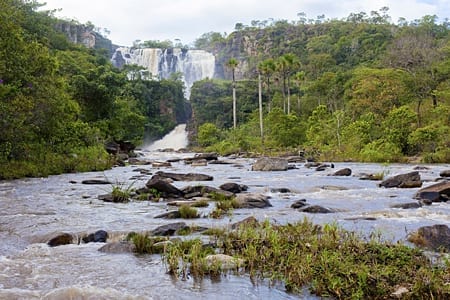By Daniel de la Calle
The screening in Goiania marked the beginning of my last week in Brazil. I sped up the visits to the açai na tigela parlor, tried to look more closely at plants in the parks and to spot all the macaques on the electric wires; ay! so many things I would not be able do back home. It was also the time to revisit the places and people I met last year on my first visit to the country.
Goiania is not pleasing to the eye, no. No historical landmarks, no beautiful neighborhoods, no pretty avenues, no magnificent gardens, no cultural life to speak of. It feels provincial, but is home to 1.5 million people. Still, locals are proud and quick to tell you that year after year it is labeled one of the top two cities to live in Brazil and also that its beautiful women, seven to every man, are famous nationwide. Now, this is something people from Minas Gerais strongly disagree about, but I want to believe goianienses.
Goias’ wealth comes from cattle and farming (primarily soy) and from the car industry. These activities seem to be putting tremendous pressure on the “cerrado” ecosystem, making it the most threatened area in all Brazil, above the Amazon. It is always tragic to see or hear of an endangered environment, but with the “brazilian savannah” this is even more the case, because walking or driving through it is where I have seen the most beautiful landscapes in the tropics.

The cerrado is both open and bushy to the point of being dense, jungly with abundant and unique varieties of trees and birds. At times it resembles a garden of Eden, a primeval forest that has not seem man yet. Everywhere you see red termite mounds, wild grass and scattered endemic palms that break the tree line deciding to reach up higher.

Toucans, araras and other smaller birds feast on the different kinds of dates and tiny coconut-looking seeds they produce. The plants are striking, many twist around in still violence, a testimony to the six months without rain. They are resinous and fragrant and bear unique fruits that locals eat in popular dishes and ice cream. My beloved pequi would deserve a whole paragraph, but I know I am already overextending myself here, so I will leave it to your curiosity and to Wikipedia to find out more. Love pequi. Love love love it.

Was it a dream or did three blue and golden araras just fly over our heads?
We arrived by car from Brasilia the afternoon of the screening. On this occasion I had no worries as to how things would turn out: this is the city where I know the most people in the country and I had had so much help from everyone to promote the event and send out emails that I felt calm. Eudaldo Guimaraes deserves special praise and a huge thank you for all his help providing contact information for so many crucial people around the country, not just in Goiania, and for sending me many copies in different formats of the Portuguese subtitled version of the film. What a man, the kind you need if you were to begin to losing hope in humankind. Anyway, the screening went very smoothly, with a really pleasant vibe among the audience and the Q & A stretched itself into almost infinity. Yes, Brazilians really love to engage in the art of conversation, adore acquiring information, socializing and listening to their own beautiful voices and language. I myself felt somewhat awkward. The cinema was rather long and narrow and I must have suffered from flight attendant complex; it was also weird to talk in front of friends in a more formal manner and with a microphone. Still, it was a success and it sure feels sensational to get such a shower of kind words of praise and good intentions on behalf of the A Sea Change crew. All those men and women, all the kids that came to the screenings clearly see the flaws and want a better world, a society more respectful towards nature where the real priorities are put at the top of the list. I am not much of a believer in large groups of people and majorities, but stand fully convinced most people in the world want exactly that. That question Sven so emphatically asks in the film (man, after seeing it 20 times it seems to be engraved in my brain!) comes to my mind: “Why is it so hard?” I think we have to be louder, because we are more and we want the right thing.
As an anecdote, it was in Goiania where I for once had no clue what to respond to a question from the audience. Someone raised his hand and asked why o why Barbara Ettinger had chosen so and so font on the film, what the meaning behind it was. Boy did that catch me off guard. It is quite a testimony about how shameless (“cara de pau” in Portuguese, “caradura” in Spanish) I have become during these past five weeks: to be able to answer all possible questions about ocean acidity, global environmental policies, biodiversity or the future of the planet and only choke when when we finally stepped into the kingdom of typography.
A final note: the next morning I was very fortunate to attend a private screening of the film Oceans in its original hoarse and sexy French version. It is an absolute feast to the eyes, I strongly encourage you to go see it if you get the chance. This is the French site with the trailer:

The last sunset, on the way to Sao Paulo


